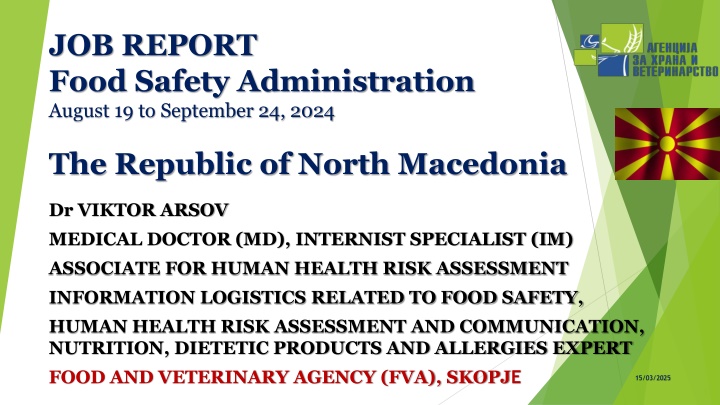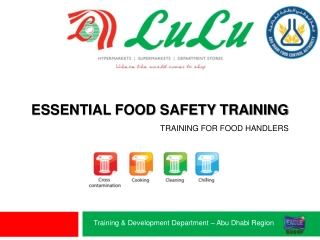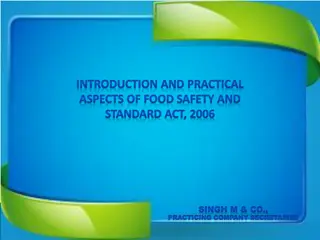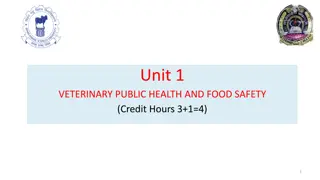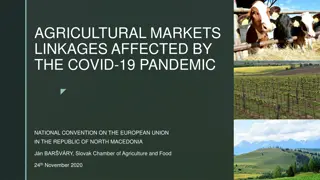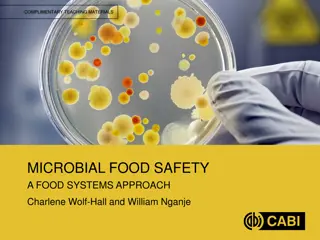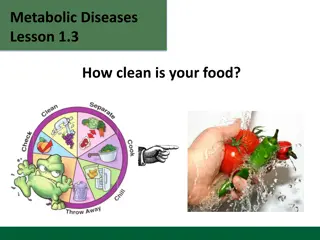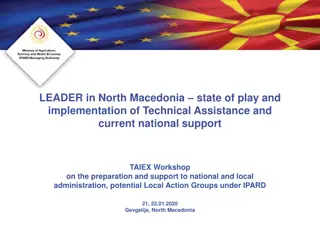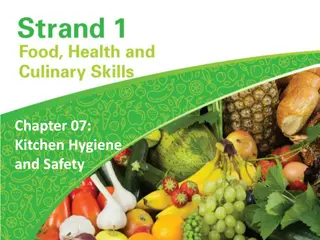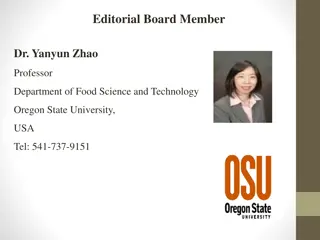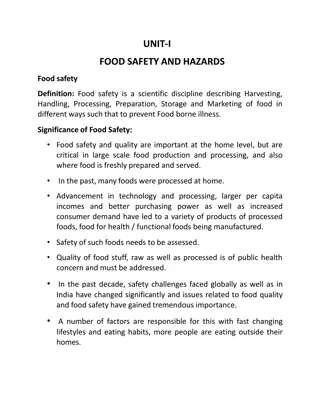Food Safety Administration Report in North Macedonia
Dr. Viktor Arsov, an expert in human health risk assessment, nutrition, and food safety, provides insights on the food safety situation in the Republic of North Macedonia. The report covers data on the population, households, and dwellings, along with the regulatory efforts and risk assessment processes implemented by the Food and Veterinary Agency.
Uploaded on Mar 15, 2025 | 3 Views
Download Presentation

Please find below an Image/Link to download the presentation.
The content on the website is provided AS IS for your information and personal use only. It may not be sold, licensed, or shared on other websites without obtaining consent from the author.If you encounter any issues during the download, it is possible that the publisher has removed the file from their server.
You are allowed to download the files provided on this website for personal or commercial use, subject to the condition that they are used lawfully. All files are the property of their respective owners.
The content on the website is provided AS IS for your information and personal use only. It may not be sold, licensed, or shared on other websites without obtaining consent from the author.
E N D
Presentation Transcript
JOB REPORT Food Safety Administration August 19 to September 24, 2024 The Republic of North Macedonia Dr VIKTOR ARSOV MEDICAL DOCTOR (MD), INTERNIST SPECIALIST (IM) ASSOCIATE FOR HUMAN HEALTH RISK ASSESSMENT INFORMATION LOGISTICS RELATED TO FOOD SAFETY, HUMAN HEALTH RISK ASSESSMENT AND COMMUNICATION, NUTRITION, DIETETIC PRODUCTS AND ALLERGIES EXPERT FOOD AND VETERINARY AGENCY (FVA), SKOPJE 15/03/2025 1
The Census of Population, Households, Dwellings (21) In the total resident population(1,836,713 persons), 50.4% are women and 49.6% are men, 58.44% declared themselves as Macedonians, 24.30% - Albanians, 3.86% -Turks, 2.53% - Romas, 0.47% - Vlachs, 1.30% - Serbs and 0.87% - Bosnians. According to their religious affiliation, 46.14% declared themselves as Orthodox, 32.17% - Muslims (Islam), 0.37% - Catholics and other (Evangelists, Jehovah s Witnesses, Buddhists, Atheists). 2
Food Safety Situation FVA is an independent governing body with responsibilities in food safety area incl. the control of national reference and authorized laboratories with public health relevance providing human health protection from foodborne diseases, poisonings and consumers protection, communicating scientific based risk assessment information on food hazards, food poisonings, emerging risks, product recalls and withdrawals, environmental protection etc. timely and transparently. Also it implements regulatory legal acts in liason with EU and international food standards through food inspection control, supervision and monitoring; National bodies responsible for risk assessment and scientific advice using qualitative and quantitative approaches, data collection methodologies are: 1.National Council (NC) for Food and Feed Safety (Scientific Experts in 10 Panels); 2.Risk Assessment and Communication Dept. within FVA. National Monitoring subprogramme for food safety includes monitoring of pesticides residues and metabolites, microbiological criteria, mycotoxins, heavy metals, nitrates, GMOs, food additives, other chemicals in food, food supplements, irradiation treated and organic food; Department for Inspection Supervision conducts offical regular controls and extra surveillances of FBOs on different and diverse food commodities. 3
Risk Assessment and Communication Dept. Risk Assessment Unit utilizises databases with comprehensive literature research of scientific articles, papers, reviews, guidelines, opinions, online professional libraries to provide scientific-based risk assessment opinion on food hazards applying scoring prioritization protocol. It s involved in developing, publishing educational brochures, professional monographs, publications, books, guidelines for scientific auditorium, general public, consumers, patients, international food safety authorities; Risk Communication & RASFF Unit is a national EU RASFF contact point. Through the "RASFF Window" app, it receives notifications for unsafe food that s imported in, or originates from our country and administrative actions and offical response to the EU Office in the country, and EU RASFF team in Brussels. undertakes 4
Job Duties in Risk Assessment & Communication Dept. Providing statistical data analysis from the national database related to chemical, microbiological, biological and other hazards in food; implementing integrative approach of risk analysis with focus on risk assessment and communication; Developing, designing, publishing professional monographs, educational and informative brochures, books, scientific papers, articles and other relevant publications in scientific journals and official gazettes, uploading it on offical institutional website and distribution to different media that are intended for the general public (consumers), scientific auditorium, patients, international food safety authorities and organizations with information on specific foods and risks related to food safety and associated chemical, microbiological and other hazards as well as information and guidelines created for official inspectors; Providing scientific risk assessment/expert opinions on demand or self-mandated related to food hazards and emerging risks according to internationally developed and accepted risk assessment and data collection methodology using qualitative, semiquantitative and quantitative approach in exposure assessment calculations and risk characterization where applicable; Involvement in past and ongoing project activities related to institutional strengthening of Risk assessment and Communication (creating data sources mapping protocol, risk prioritization protocol with scoring system criteria); National Expert of Scientific Panel for nuitrition, dietetic products and allergies under National Council. 5
Three major issues related to my work that need to be improved 1) Effective communication, coordination, cooperation between Risk Assessment and Communication Dept., domestic and international scientific institutions, academia, experts, laboratories (official and private involved in food safety testing, food poisonings, hospitalized and death patients), consumers, Department for consumers complaints, Risk Management/Inspection Department, industry and public sector in liason with National Food Safety Legislation. Risk Communication Strategy an Project Activities. 2) Conducting national consumption/dietetic surveys for general population or stratified by different variables (age, sex, ethnicity, religion, culture etc.), including vulnerable subpopulations (pregnant women, immunocompromised, patients with cancers and other chronic diseases) for creation and running National consumption database as prerequisite for the third - crucial step od scientific-based risk assessment (dietetic exposure assessment). Completition of comprehensive and integrated approach of risk analysis. Project Activities. 3) Updating the National Monitoring Programme for the control of pesticide residues (agricultural chemicals), food additives, dioxins, mycotoxins, PFAS, PCBs, heavy metals, antibiotic, antifungal residues and metabolites, acrylamid, endocrine disruptors, prohibited substances as stimulants, amphetamine, ephedrine, anorexigens, androgen anabolic substances (AASs), hormones, beta 2 receptors agonists in food, food supplements, food for sportists and special medical use, fortified food, novel food, GMOs as well as emerging risks based on mandated or rapid risk assessment opinion. Financial Analysis/Budget Planning. 6
The challenges that I face in my everyday work Administrative and technical problems that refer to insufficient data from lab reports, lack of unified data collection system due to incongruent laboratory softwares / IT incompatible solutions between different lab reports providers; Insufficient number of employees in the Risk Assessment and Risk Communication Dept. with educational background in food safety, human medicine, risk assessment, toxicology, microbiology, epidemiology, statistics, mathematics, IT developers and inconsistency in human resources professional development; Lack of financial funds/budget for expert engagement in National Council and Scientific Panels; Limitations in laboratory testing capacities, especially for chemical contaminants like PCBs, PFAS, acrylamide, dioxins, mycotoxins other than aflatoxins and ochratoxin, food additives etc.; 7
The challenges that I face in my everyday work Unsatisfactory data providing, reporting and bad official communication between Departments involved in food safety risk analysis and risk assessment, intra- and interinstitutional working plans, priorities and stuff collision as well as conflict of intersts an interpersonal professional relationships; Non representativeness of collected data in previous decade/unavailable data due to absence of National dietetic surveys for consumption habits of population groups for relevant and diverse food items/categories or insufficient and scarced designators/lab reports descriptors for sound exposure assessment calculations, derivations of objective risk characterization and exporting final risk assessment report compatible with the EU Comprehensive Consumption Database and utilization of EFSA and other dietetic exposure statistics softwares, online available tools. 8
Topics/subjects of interest that may help resolve the challenge Knowledge of how should be designed, implemented, developed and maintained an efficient national food safety control system that contributes to sustainable trade, because strong system is prerequisite for the development of the risk analysis; what are system requirements regarding action and cooperation and involvement by the relevant private and public stakeholders from the food industry, consumers organizations, universities and other scientific institutes; Scientific knowledge of different aspects of food safety and quality, including risk perception, risk analysis and its application in practice because of the daily need for such knowledge in the working process; how institutional governance and cross- border trade affect the design of laws, standards and food safety control systems and application of the knowledge and skills in the daily work. 9
Topics/subjects interest that may help future situation The most interest content of the core phase would be the insight of the food sanitation administration in Japan, food safety risk analysis and contaminants monitoring systems with public health hygiene measures and possibility for implementation and transposition of some of its aspects into national food safety system. Additionally, marine toxins are interesting subject, because my country is importer of seafood and recently there is huge import of diverse species of sea fish, crustaceans and bivalve molluscs from abroad that can cause foodborne poisoning; Furthermore, I expect that somekind of country applicable dietetic exposure assessment calculation tools with predicative modelling will be presented at the course, especially in cases when quantitative data availability is limited and HACCP modelling, monitoring data and hospital records on morbidity and mortality of foodborne diseases with scarce laboratory reports data and inspection surveillances records are major contributors for derivation of risk characterization and final risk assessment opinion that will be communicated to inspectors and other stakeholders. 10
